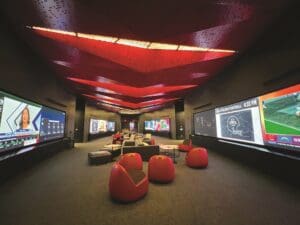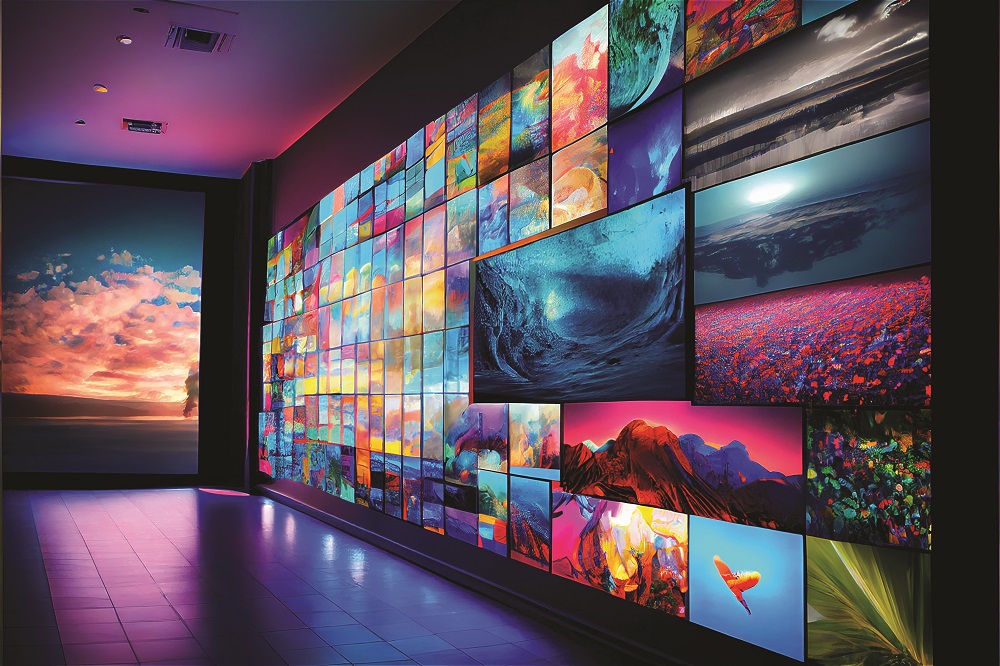If you swim in commercial AV circles, you probably come across the terms “4K” and “8K” a whole lot — on marketing spec sheets, during industry events and on the jobsite. The terms, which, of course, refer to ultra-HD display resolutions, have also entered the popular consciousness, with techies of all stripes eager to snap up the most dazzling displays they can get their hands on. But how much of 4K and 8K fever is marketing hype and how much is truly meaningful? Are there lots of ultra-HD applications, natively displaying ultra-HD content, “out in the wild”? And how does human visual acuity — in short, our ability to perceive fine detail — factor into whether an ultra-HD investment is worthwhile? This month, Commercial Integrator explores these questions in detail.
To help us with our task, CI draws on the expertise of Aaron Peterson, CTS-D, CTS-I, DMC-D 4K, senior solutions engineer with technology partner Mechdyne Corp.; Brandon Creel, CR-T, CEE, CTS-D, partner with AV consultancy Hewshott; Kathryn Taub, product marketing manager – networked video, Audinate; Mike Pedersen, CTS-D, CTS-I, audiovisual experience manager, Iowa State University (Iowa State); and Will DeWitt, learning environments manager, University of Southern California (USC). Their multifarious views on the topic of ultra-HD paint a nuanced picture of when contemporary integration businesses should (and shouldn’t) consider leveraging the technology.
Latching Onto Terms
“Much like the camera megapixel race or the ever-increasing computer clock speeds, industries love to latch onto terms that are easy for the layperson to understand,” DeWitt observes. Indeed, the “approachability” of 4K and 8K is likely why the terms have seeped into the popular consciousness. As Taub explains, “People don’t like jargon and prefer the simplicity of terms like 4K and 8K as compared to 1080p or 2160p. Coupling that concept with the sometimes-misleading premise of ‘bigger is better,’ then 4K erroneously must always be better than 2K, and 8K the ‘best’ of all.” Commercial AV manufacturers are savvy marketers, and they’ve seized on that over the last several years by leaning heavily into 4K resolution/compliance in everything from advertising to product packaging. This, Creel says, has led to clients introducing the resolution spec into project-planning conversations.
Listen: AV+ Podcast: Jeff Singer on Solutions-Driven Marketing, Intentionality in Business
But, of course, integrators and consultants’ highest calling is to educate, selling their expertise first and foremost. Creel reaffirms the frequency with which clients ask about ultra-HD resolutions but reframes this as an opportunity for Hewshott to dig into the project and determine which resolution is actually needed. He rattles off just a few of a series of qualifying questions, asking, “How is it going to be used? How is content going to be delivered? Is it going to be compressed or uncompressed?” Mechdyne’s Peterson reinforces this, declaring that integrators and consultants, as well as savvier technology managers, tend to zero in on the use case of the room and the content being displayed. By doing their due diligence, he says, solutions providers empower themselves to lead the client to a display system that’ll be right for them and their use case.
Digging Into the Math
Assessing the suitability of ultra-HD for a given environment involves much more than vibes and feels; as Iowa State’s Pedersen explains, it involves doing the math and factoring in the imperfections of the evolved human eye. “With 20/20 vision, the discernable limit of the human eye is about 1 arc-minute of detail, approximately 0.0167 degrees,” he says. Using that information and some basic geometry, it’s possible to determine the theoretical perceptive pixel density at any viewing distance. “For a typical classroom, at 20 feet of viewing distance, the perceptive pixel density is around 14.3 pixels per inch,” Pedersen explains. “Applying that pixel density to a 3840×2160 image creates a screen that is roughly 22 feet wide by 12.5 feet tall.” The impracticality of a hypothetical application like that is one reason, at Iowa State, Pedersen and his team focus more on ease of integration, reliability, customer support and price than on chasing higher resolutions.

Full HD routinely wows clients who have large-scale auditorium, theatre and event-space deployments. But it’s incumbent on consultancies and integrators to present their clients with budget numbers so they can make educated decisions on what to invest in. Photo courtesy of Hewshott.
Taub describes the utility of ultra-HD displays/content to relative viewer distance, saying that, for a 4K display, the optimal viewing distance is 1.5x the screen height; meanwhile, the optimal viewing distance for 8K is 0.75x the screen height. “Beyond that distance, fine-edged details begin to blend together because the human eye can’t discern individual pixels,” she explains. This echoes observations from Mechdyne’s Peterson, who mentions live events that feature big LED walls. Drawing on his own experience, he says, in most cases, the pixel pitch only goes down to about 2.6 millimeters. “The reason is, when the first row of your audience is 30 feet away from your LED panel, you don’t need it any better than that,” Peterson explains, saying a 1080p image looks beautiful from a distant viewer’s vantage point.
Where Ultra-HD Works
Naturally, though, none of this is to say that ultra-HD doesn’t have lots of ideal applications. Peterson says, a few years ago, his firm Mechdyne, which frequently works with visualization engineers, encountered a client whose team expected to be one foot away from the videowall. “He wanted a tiled wall of displays with the highest number of pixels per inch he could get,” Peterson explains. “He wanted to be able to be right next to the display, look at it and then physically walk from that one to the next one to compare images side by side.” In short, he says, the larger the image, and the closer the viewer will be to it, the more compelling the value proposition for ultra-HD will be.

For a 4K display, the optimal viewing distance is 1.5x the screen height; meanwhile, the optimal viewing distance for 8K is 0.75x the screen height. Beyond that distance, fine-edged details begin to blend together.
Admittedly, the use case above is a pretty niche application, so let’s consider more common scenarios. According to Taub, ultra-HD is a core requirement in many elements of the healthcare vertical. “For example,” she begins, “medical imaging is an ideal use case for 8K content, where fine detail analysis is paramount.” Taub adds that teaching hospitals and medical schools depend on ultra-high-resolution content to help students make accurate diagnoses. Iowa State’s Pedersen, who generally expresses skepticism about ultra-HD’s utility, readily concedes that specific education applications call for it. “Certain disciplines here at Iowa State, such as engineering, astronomy, geographic information sciences or veterinary sciences, would certainly have applications that could benefit from 4K/8K,” he acknowledges. “These would be applications where the users would be a couple feet or a few inches away from the screen, studying fine details.”
Meanwhile, Creel spotlights digital signage, saying it’s very typical to find 4K signage displays in lobbies and other public environments these days. The real question in those use cases, he says, is how to get 4K content onto those screens. “There’s nothing better than having 4K content displayed on 4K TVs,” Creel enthuses. “It just looks great.” (Shortly, we’ll dive into the practicalities of doing that.) Creel also points to broadcast as perfect for ultra-HD, saying, in that world, the imperative is not to disrupt, change or modify the signal. He notes that four full-HD signals can be displayed natively, in multi-view format, on a 4K display; meanwhile, up to 16 full-HD signals can be shown natively on an 8K display. Citing simultaneous display of multiple signals, Creel declares, “In that broadcast and monitoring world — and that extends to control rooms even outside of broadcast — the higher-resolution displays are really beneficial.”
Related: Commercial Integrator Expo Partners with Digital Signage Federation for Educational Program
Finally, esports is another category where ultra-HD might add considerable value. According to Taub, “Esports absolutely requires ultra-HD displays, but most [applications] require a frame rate of at least 120fps, if not higher.” Creel expands on the latter point, describing esports as the number-one sector where frames per second and refresh rate matter. Indeed, he calls a display’s refresh rate equally important as its resolution for graphics-intensive esports environments.
Where Ultra-HD Isn’t Needed
With those applications being great fits for ultra-HD displays/content, we’ll now turn to use cases where full HD is fully sufficient.
If you ask Iowa State’s Pedersen, most applications fall into this latter category. Referring to his own school, he explains, “The projectors on campus are predominantly 1920×1200 resolution, but we operate them all in 16:9 at 1920×1080.” Pedersen readily concedes that bulk of the flatpanels Iowa State has purchased in the last four years are native 4K, but he says that’s simply because that’s the resolution of the base glass that all manufacturers use now. “Like the projectors,” he continues, “to my knowledge, they are all operating at 1920×1080 resolution on a day-to-day basis.” Speaking with his trademark candor, Pedersen declares, “We are really not focused on these types of gee-whiz specifications.” At Iowa State, he adds, the vast majority of content is in the form of presentations that simply don’t demand high resolution, 10-bit color, high dynamic range (HDR) or Rec.2020 color space.

The interior space of the Cyclones football team in Iowa State’s Stark Performance Center. Each of the four curved displays is approximately 30 feet long by six feet high. Content is managed by a large windowing processor that can have 360-degree content. Photo courtesy of Mechdyne
USC, where DeWitt works, has a similar mindset. He explains that, although all the university’s core infrastructure can handle 4K, there’s rarely a need for it outside of critical viewing spaces. “The default install tends to be 1080p/full HD, with 4K as futureproofing,” DeWitt says. “Enabling 4K where it’s not needed only adds to bandwidth overhead for no real benefit.”
Creel attests that Hewshott still does a lot of large-scale, full-HD projection, which, he declares, looks phenomenal. “So many times, we’ve gotten the request, ‘For big projection and movies, we want 4K,’” Creel relates. “And I have to ask, ‘Why?’ And they’re not sure…they don’t know.” He reaffirms that full HD routinely wows clients who have large-scale auditorium and theater deployments, and he adds that it’s incumbent on consultancies like Hewshott to present the client with budget numbers so they can make an educated decision. “To go from a WUXGA or an HD projection system to then a 4K all the way through, there’s a significant additional cost to get there,” he observes.
‘All the Way Through’
“All the way through” is worth focusing on because, if we’re talking about true ultra-HD applications, we’re talking about not only the displays but also the content, which must be transmitted faithfully to them.
“[Transmission has] been the limiting factor,” Mechdyne’s Peterson states, adding that we might see more plentiful ultra-HD content as barriers to transmission are lowered. Right now, he says, it’s often a game of making compromises between resolution and refresh rate. Expounding on bandwidth-related challenges, Taub concurs that they’re the main limiting factor for ultra-HD content and that they often necessitate escalating compression ratios. “It’s certainly possible to compress an ultra-HD stream down to transmit over smaller network connections,” she explains. “You just have to increase the compression ratio. That said, you may not be happy with the output quality…. Excessive compression may introduce artifacts in the output, which can include blocking, ringing, blurring, solarization, posterization and mosquito noise.”
Related: Crimson AV Adds LED Experts Group
This is where network-infrastructure considerations come to the fore. Although plenty of network implementations still run quite successfully on 1Gb infrastructure, Taub observes that price points for 10Gb switches are continuing to drop. “Many large companies already have a 10Gb backplane in place,” she notes, adding that 20Gb and 40Gb backplanes aren’t far behind. Nevertheless, she states, outside of specialized broadcast facilities running 40Gb-plus backplanes that are dedicated to AV, nearly all network-distributed ultra-HD content is going to be compressed. “Many of today’s compression algorithms are visually lossless and can run on 1Gb infrastructure without great detriment to video quality,” Taub remarks. She adds that, apart from lowering resolution, it’s possible to change frame rate, color space, chroma subsampling and color bit depth to decrease requisite bandwidth.
Further complications arise when AV signals ride on the same corporate network that core data does. “Video streaming must be managed carefully in order to be included on a converged network,” Taub advises, noting that some IT managers prefer to keep AV traffic segregated onto a separate network or VLAN to avoid problems like oversubscription or port flooding. “Proper configuration of Quality of Service (QoS) and multicast management settings on the switches is critical to a healthy, stable network,” she adds.
Is Ultra-HD Content Even Available?
But are we getting ahead of ourselves here? For years, AV professionals have noted the dearth of ultra-HD content to populate all these dazzling displays. It’s worth considering whether that situation has changed. On that question, our experts differ.
Iowa State’s Pedersen doesn’t mince words, saying, “No, I have not seen a substantial rise in available ultra-HD content. The demand simply isn’t there.” Offering a similar view, DeWitt says, “Probably the greatest limiting factor is obtaining source material greater than 1080p. It is only in the specialty areas where you tend to see resources devoted to being able to store and play back 4K or higher material.” And even if ultra-HD content is more available, DeWitt, who’s situated in higher education, just hasn’t seen it used outside those specialty areas. “Most teachers are displaying or streaming things off their laptops and don’t need anything greater than 1080p,” DeWitt opines. “Coming out of the pandemic, we still have a lot of Zoom being used in classes, at which point you’re usually dealing with 720p anyway.”

These days, it’s hard to avoid displays in out-of-home environments, ranging from offices and meeting rooms to more experiential entertainment spaces like esports arenas. These eye-catching displays run the gamut from DVLED, to LCD monitors, to projection systems. Photo courtesy of Hewshott.
Creel offers a different view, pointing to digital signage and a relative abundance of in-house-built ultra-HD content populating those displays. “A lot of our clients do that, and their digital signage is 4K native throughout,” he explains. Peterson builds on that point, explaining that most of Mechdyne’s clients generate their own content. Using common tools including Unreal Engine and Unity, these clients are creating their own environments and content at ultra-HD resolutions. This approach entails a considerable cost, however. As Creel observes, it’s not sufficient just to make that custom content once when the project is built and brought online. “How about in six months, or a year, or three years down the road?” he asks. “People don’t want to be watching the same content from before.”
Taub broadly echoes Creel and Peterson, citing falling price points for 4K cameras, which is making them more widely available to casual users. “In fact,” she says, “many people carry a 4K camera in their pocket in the form of their mobile phone.” Taub adds that most streaming services offer 4K options, with quality automatically adjusting based on available bandwidth.
Other Key Specifications
Over the last several years, those of us in commercial AV have had a collective consciousness raising as regards the primacy of experiences over speeds and feeds. Against the backdrop of that mental reset, 4K and 8K fever sticks out even more. Turning, then, to the topic of specs, our experts argue that resolution is just one of a constellation of display characteristics worth considering. In particular, they highlight HDR as hugely impactful. As Creel puts it, “You take an SDR solution, and you compare that to an HDR solution, and it’s — woah! — it looks totally different.” In fact, he says, many clients opine that a full-HD system with HDR looks better than does a 4K system with SDR.

With regard to digital signage, it’s very typical to find 4K signage displays in lobbies and other public environments these days. The real question in those user cases is how to get 4k content onto those screens. Photo courtesy of Hewshott.
Mechdyne’s Peterson underlines that point, citing, in particular, prominent brands whose iconography is legendary. “Color reproduction is huge for a lot of companies in the commercial world,” he states, citing the John Deere brand’s immediately recognizable green as just one example. “If that iconic green is not generated properly, it’s not the same color,” he declares, driving home how big a problem it would be if onsite corporate displays could not reproduce John Deere’s logo and branding faithfully. Offering another example — Coca-Cola red — Peterson says that, for a lot of companies, color reproduction outstrips resolution, refresh rate or any other variable. DeWitt hypothesizes that one reason HDR is nevertheless less bandied about is its relative complexity to convey. “Each manufacturer has their own marketing names for it,” he says, “and, again, it’s hard to explain the importance and what color gamut, local dimming, nits, et al., actually mean.”
But even if those other specs require a bit more explanation or elaboration, they’re hugely consequential to integrators’ ability to deliver outstanding outcomes. Creel says that’s particularly true with regard to brightness. He laments that, frequently, clients will call out a need for ultra-HD while, at the same time, not having a clear idea of how bright their display should be. “[Brightness] is key,” Creel states, “and [it’s] huge to the end-user experience. If you can’t actually see the TV because it’s not bright enough, your experience is poor.”
Takeaways for Integrators
What takeaways can integrators draw from the preceding discussion? That’s where we turn next.
Iowa State’s Pedersen views it as a clarion call for integrators and end users alike to better understand the scope and requirements of the content intended to be displayed. “If the proposed content (e.g., PowerPoint) would not benefit from improved specifications, keep it simple,” he advises. “If the content might benefit from 4K/8K, or something like 10-bit color, then evaluate the viewing environment.” In the latter cases, Pedersen says integrators must focus on working closely with clients to ensure the viewing environment is suitable for the technology being proposed, evaluating factors such as image size, viewing distance and ambient lighting. For his part, DeWitt laments that solutions providers too often overlook environmental factors that affect the user’s viewing experience. “For example,” he adds, “I’ve seen people unplug displays because they were too bright in a dim room, [and I’ve seen] cheaper displays that serve no purpose because they’re too dim in a room that gets direct sunlight.”
One part of it is for technology partners to be confident enough to push back on a client whose ideas might be mistaken. As Mechdyne’s Peterson puts it, “When our clients come to us saying, ‘Hey, I want a 4K image’ — because that’s just the buzzword — we need to listen to them [and] figure out what they really want to do.” That involves asking all those qualifying questions and discerning the right solution, even if it differs from the original ask. Creel characterizes these efforts as lying at the very heart of a consultant’s role, which he describes as “Trying to extract out of the client what they actually need.” By asking detailed questions about the content that will be shown, how many viewers there will be, the average viewing distance, etc., technology partners empower themselves to provide solutions that best suits their clients.
Takeaways for Manufacturers
What can the manufacturer community take away from this? Our experts are happy to weigh in.
Taub underscores a point we’ve made previously, saying, “Marketing terms like 4K make it easier for laypeople to understand, or at least form a comparison between, products and competitive offerings.” That invites the question of whether marketing based on resolution is still effective. For his part, Iowa State’s Pedersen answers that question in the negative. “It is honestly going to be a challenge for manufacturers in the future, as we have reached the practical limits of visual perception, particularly with resolution,” he argues. “They can’t simply build new sales on increased resolution specs.” Pedersen also points to the exponentially greater storage space and bandwidth required for ultra-HD formats — from 4K to 8K to 16K — and says, “With significantly declining returns on the visual perception of the increased resolution, the cost-benefit ratios simply don’t make sense.”
What, then, should manufacturers be focusing on? Iowa State’s Pedersen is quick with an answer: ecosystems — in particular, AV-over-IP. “Developing displays with direct AV-over-IP inputs would be a tremendous benefit,” he propounds, while adding, “Of course, this ideally depends on our industry finally deciding to develop one universally accepted AV-over-IP standard.” Pedersen also urges a continued focus on mechanical specs, such as efforts to make displays thinner and lighter. DeWitt adds two other items to the list for manufacturers to consider: options for mounting accessories (webcam/speaker bar) directly to the display and better control (LAN/RS-232). “[These] are all things that would be a larger benefit than an imperceptible increase in pixel count,” DeWitt concludes.
For his part, Mechdyne’s Peterson offers a paean to transparency in spec sheets, urging vendors to be forthright about what their products can really do. “Be honest with what your display is actually doing,” he exhorts. “If you’re a projector that has an actual native resolution of 1920×1080, and you’re using pixel shift to do your 4K enhancement, make sure that’s on your spec page, please.” After all, integrators are on the front lines, selecting products to meet a use case’s specific requirements and trying to deliver incredible experiences. That requires not only abundant information but also accurate information. “Just be upfront with it,” Peterson urges.
However much pomp and circumstance might surround 4K and 8K, they are, in the end, just specs — and resolution is merely one spec among several (e.g., color gamut, refresh rate, brightness, contrast ratio, weight, power consumption) that materially affect the success of any use case. Rather than allowing themselves to develop tunnel vision and focus on resolution alone, our experts recognize the user experience is the sole determinant of whether a technology application can be deemed successful.
“What people hire us for is the outcome,” Creel concludes. “When everything’s done, it’s [about] the experience that they have. That’s what they care about, and that’s what we deliver on.”










